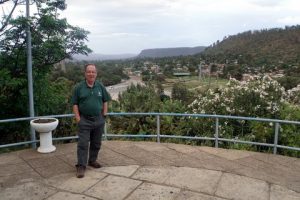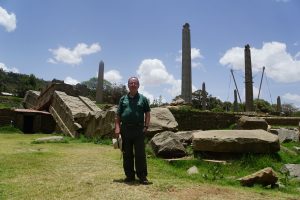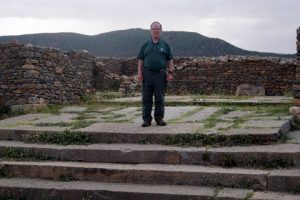My morning began with an early rise to send the blog out. About two minutes later, I got a frantic email from my travel agent, who had panicked when she read the title: “I went through hell yesterday.” She assumed that something had gone wrong with the trip, and I had to assure her that while it was her “fault” I had chosen to come to Ethiopia (she had given me a brochure from the company last year, and when I saw the “historical tour,” I knew I had to take it if I were to come back to Africa), I was really having a wonderful time.
That wonderful time continued as I took an hour plane ride one hour north to the town of Aksum, another world heritage site because it was the location of one of the most powerful dynasties in the Greco-Roman world. Aksum was the capital of a kingdom that ruled for nearly 700 years, (early B.C. through the 700s); it was where King Ezana took in a shipwrecked missionary who converted him to Christianity, and where a century later, nine Saints from Syria made Ethiopia part of the “Oriental” (that’s the word they use) Orthodox church. Forty five percent of Ethiopians call themselves Christians today. It was interesting to see coins at the (modest) archeological museum, because the kings issued coinage with their pictures on one side (there were 53 rulers), and on the other, the moon and sun, symbols of pagan gods, until a cross decorated the other side when the rulers adopted Christianity.
The kingdom had one thing Ethiopia lacks today—access to the rest of the world through the horn of Africa. At one time, Askum stretched across the Red Sea to Yemen (whose suppression led King Ezana to have chiseled his accomplishments in the Ethiopian “Rosetta stone”—Greek, Geez, and Sabean –enabling scholars to read ancient documents), with a major port in what is now Eritrea to connect the country with the Mediterranean and Asiatic worlds. One of the traded products was frankincense, and the Ethiopians believe King Bazen was one of the 3 wise men who traveled to find the Christ child. Today, the country is landlocked, and my guide told me that egress (look that one up) is through Djibouti, which exercises its power to extract tolls much the same way the robber barons did in Germany. Eritrea (and I learned this today) was part of Ethiopia for a while, but when the people threw out the communists, Eritrea sought independence. I’m only 30 miles or so from the Eritrean border, and while I might be able to cross it, Ethiopians cannot for political (and possibly religious) reasons.
The city is known for its magnificent obelisks, weighing over 100 tons, and up to 125 feet high. The park in front of my hotel has most of the royal ones, which of course are the highest. One is called the “Rome” Stele—because Mussolini took it down and shipped it to Italy, where it remained in front of the foreign office until the last ten years, when a treaty brought it back to its original sight. The obelisks lasted until Christianity considered it pagan—alas—but the stonecutting the Aksumites practiced was perfected in the churches at Lalibela that I saw yesterday. There are other steles scattered elsewhere in town, but the discovery has been sketchy. Most of the ones uncovered, beginning with a German expedition in 1906, had been covered with dirt over the years, and there is speculation that quite a bit of the ancient civilization remains to be discovered. I’m tempted to take a shovel tonight…..I’ll resist. Until about 700 AD, it was a dominant power. The rise of Islam was one of the factors that caused its deterioration and the beginning of the “dark ages” in Ethiopian history. There’s also a story that a Jewish Queen seized power and persecuted Christians, and the kingdom never recovered.
The other featured item is the Dongur, the palace of stones, locally known as the palace of the Queen of Sheba. She was reputedly from the area, and though the palace dates from about a thousand years after Sheba’s reign, her importance in Ethiopian (and Judeo-Christian) history creates a more interesting tale. After all, who can resist a story of temptation (she was reputedly one of the most beautiful woman of her era), wisdom (Solomon is involved), seduction, and birth of Menelik, their son. There are markings that could be a throne room, and of course I had to take a picture there!
Forts, palaces, churches and monasteries! Who needs to go to Europe?




